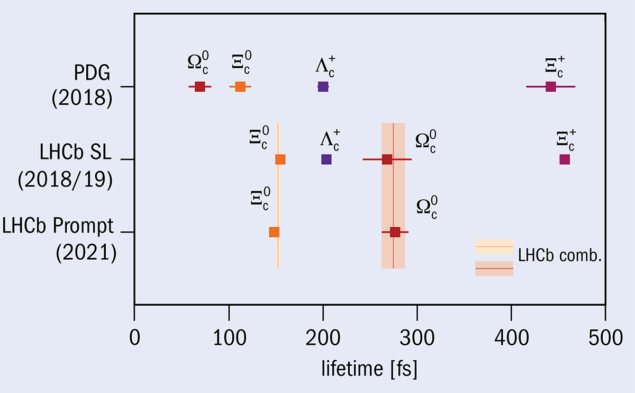A report from the LHCb experiment

Which charmed baryon decays first? The LHCb collaboration recently challenged the received wisdom of fixed-target experiments by almost quadrupling the measured lifetime of the doubly strange Ωc0. Now, a follow-up measurement by the collaboration confirms the revised hierarchy, offering valuable input to theoretical models of the decays.
The situation changed dramatically in 2018
Ground-state baryons containing a charm quark (c), such as Λc+ (udc), Ξc+ (usc), Ξc0 (dsc) and Ωc0 (ssc), decay via the weak interaction. The ordering of their lifetimes has long been thought to be τ(Ξc+) > τ(Λc+) > τ(Ξc0) > τ(Ωc0), based on measurements from fixed-target experiments nearly 20 years ago. However, the situation changed dramatically in 2018 when LHCb joined the game using a sample of Ωc0 baryons obtained from bottom- baryon semileptonic decays. That LHCb study measured the Ωc0 lifetime to be nearly four times larger than previously measured, transforming the hierarchy into τ(Ξc+) > τ(Ωc0) > τ(Λc+) > τ(Ξc0). One year later, LHCb significantly improved the precisions of the lifetimes of the other three charmed baryons using the same method, also finding the lifetime of the Ξc0 baryon to be larger than the world-average value by about 3σ (figure 1).
Theoretically challenging
The corresponding theoretical calculations are challenging. In the charm sector, an effective theory of heavy-quark expansion is taken to calculate lifetimes of charmed baryons through an expansion in powers of 1/mc, where mc is the constituent charm–quark mass. Calculations up to order 1/mc3 imply a lifetime hierarchy consistent with the original fixed-target measurements, though only qualitatively. Attempts at higher-order calculations up to order 1/mc4, however, cannot accommodate the old hierarchy, but can explain the new one if a suppression factor to the constructive Pauli-interference and semileptonic terms is written in. The origin of the suppression factor is still unknown, but probably due to even higher order effects. An independent measurement was therefore needed to confirm the experimental situation.
The charmed-baryon lifetime puzzle has now been resolved by a new measurement from LHCb using a much larger sample of Ωc0 and Ξc0 baryons produced directly in proton–proton collisions. Both particles are detected in the final state pK–K–π+. The measurement is made relative to the lifetime distribution of the charmed meson D0 via D0 → K+K–π+π– decays, in order to control systematic uncertainties. Taking advantage of the performance and detailed understanding of the LHCb detector, the lifetimes of the Ωc0 and Ξc0 baryons are found to be τ(Ωc0) = 276.5 ± 13.4 (stat) ± 4.5 (syst) fs and τ(Ξc0) = 148.0 ± 2.3 (stat) ± 2.2 (syst) fs, respectively, where the precision of the Ωc0 lifetime is improved by a factor of two compared to the semileptonic measurement. The new results are consistent with the previous LHCb measurements, and hence establish the new lifetime hierarchy. Combining this measurement with the previous LHCb results gives τ(Ωc0) = 274.5 ± 12.4 fs and τ(Ξc0) = 152.0 ± 2.0 fs, the most precise charm-baryon lifetimes to date. The newly confirmed lifetime hierarchy will help improve our knowledge of QCD dynamics in charm hadrons, and provides a crucial input to calibrate theoretical calculations.
Further reading
LHCb Collab. 2021 LHCb-PAPER-2021-021.
LHCb Collab. 2019 LHCb-PAPER-2019-008.
LHCb Collab. 2018 LHCb-PAPER-2018-028.





